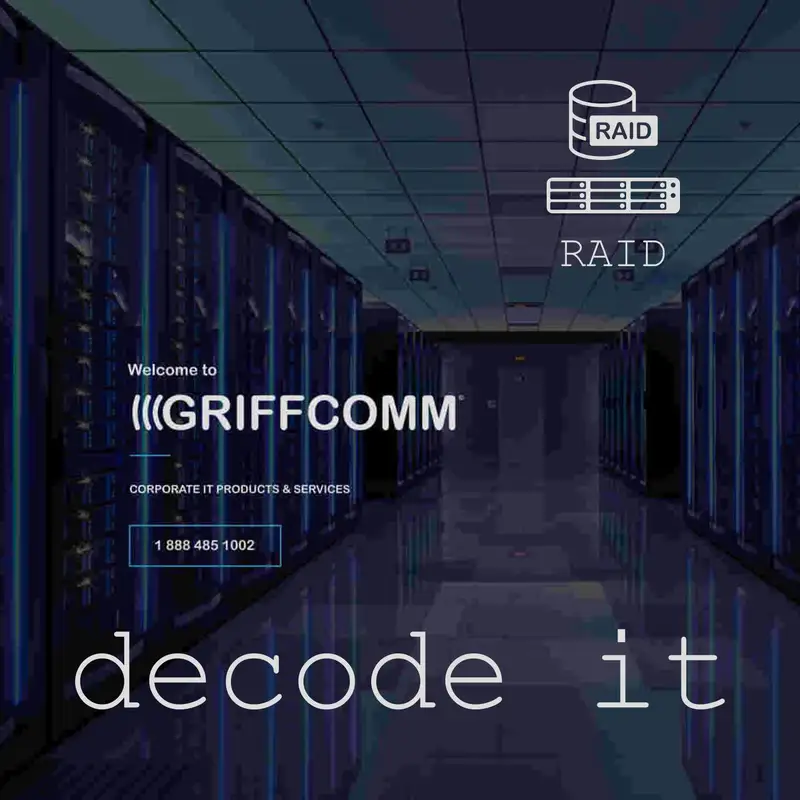Business - RAID
RAID, An acronym for Redundant Array of Independent Disks
founded in 1987 by David Patterson, Garth Gibson, and Randy Katz at the University of California
Although RAID officially was documented in 1987, various forms of its store methods were used as early as the 1960's
Using more than one drive in a single storage volume increases capacities
however also increases the possibility of failure
2 drives joined together has twice the risk of failing
the next result is a total loss of the whole data volume
RAID facilitates redundancy when combining drives together
Data store methods are denoted by the RAID name and denote protection method and read / write efficiencies
Traditional hardware RAID requires all drives be identical including the firmware used on the drive
Its very processor intensive as extra data is created called parity
which is then stored in the RAID volume in a specific structed format
in the event of a failure, the parity is used to re-create the data the lost drive had
while keeping the volume online and usable
The different types of RAID are:
RAID 0 - Data tripped over all the drives, the total capacity is all the drive added together, any drive failures will result in total data loss
RAID 1 - Mirror, total capacity is the size of a single drive, 2 drives are a duplicate of each other, a either drive can fail with no data loss
RAID 2 - Bit level striping, its deprecated, no longer used
RAID 3 - Same as RAID 2 except byte level striping, also deprecated
RAID 4 - Same as RAID 2 and 3, except block level striping
this is still used by a few manufactures, some with a propriety store method.
Its advantage over RAID 2 and 3 is data can be found on a single drive
RAID 2 and 3 has to read all the disks to collect any data
RAID 5 - Distributed, striped parity, requires a minimum of 3 drives, the total capacity is the sum of all the drives minus 1. Any drive can fail with no data loss
RAID 6 - Distributed, striped double parity, requires a minimum o 4 drives, the total capacity is the sum of all the drive minus 2, is identical to RAID5 except 2 drives cab fail with no data loss
RAID 5 and 6 are common today, RAID 6 has way more overhead on the CPU as it creates 2 sets of parity
both RAID 5 and 6 suffer the same problem of long term reliability
should a RAID 5 array of 10 drives have a failure, it has to read all 9 to rebuild the data
its not un-common to have more than a single drive fail at a time
the loss of a second drive while rebuilding will result in total data loss
RAID levels can be combined such as RAID 0+1
which would be 2 groups of identical RAID 0, then mirrored (RAID 1) together
this type of store setup is used by systems that require very high throughput such as databases or broadcast media stores
RAID has many other features not covered here such as a redundant, hot (live) and cold spare drives
Rebuild times are long, a 20Tb RAID 1 (mirror) takes around 5 - 7 days
it is however always live and available for use during rebuild at a reduced efficiency
GRIFFCOMM mostly use RAID 1, having 2 disks carrying the same data
It benefits from no CPU utilisation and double the data read speeds
My first contact with RAID was working in the UK as a network administrator in 1997, a small server running a database
then in 1999, a large food manufacture plant with 300+ staff
a single Compaq server with SCSI drive RAID system,
the backplane (the board the drives connect too) had failed taking over a day for Compaq to replace
RAID is not an easy technology to master due to its implementation being different for each manufacturer
LSI (purchased by AVAGO, then Broadcom) were the largest as they made CPUS for RAID used by many large manufactures including Hewlett Packard and Intel
Intels first attempt at RAID is called Matrix
is soft RAID in that the installed operating system is used to rebuild the RAID instead of dedicated hardware
a failed drive normally results in loosing the whole volume (in the years we have seen it in use)
Intel mow has a hardware version called ROC (an acronym for RAID on chip)
Its built in to the server CPUs and requires ROC compliant motherboards
to connect the drives too
All our servers are hardware RAID, using special long life SSD's (Solid state drives) configured as RAID 1 mirrors
entry level hardware have capacity for up to 3 virtual servers.
We use the same hardware technology for our propriety desktop and server backup solutions, remote PC support service and network monitoring proxies
When the server is in use at remote locations where obtaining replacement drives can take longer
such as in Tanzania and the Maldives we would use RAID6 which allows
for double protection buying time to find replacement drives.
Our server hardware also talks to the connected UPS power supply,
alerting us when power fails, when the battery is depleted the server is put in to a special state
when power returns the restart is quicker with no data loss.

